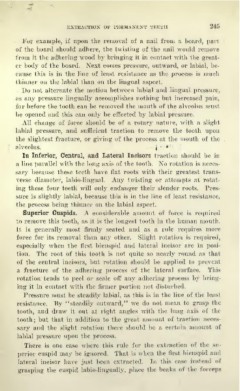Page 249 - My FlipBook
P. 249
'
EXTRACTION OF PERMANENT TEETH 245
For example, if upon the removal of a nail from a board, part
of the board should adhere, the twisting of the nail would remove
from it the adhering Avood by bringing it in contact with the great-
er body of the board. Next comes pressure, outAvard, or labial, be-
cause this is in the line of least resistance as the process is much
thinner on the labial than on the lingual aspect.
. Do not alternate the motion between labial and lingual pressure,
as any pressure lingually accomplishes nothing but increased pain,
for before the tooth can be removed the mouth of the alveolus must
be opened and this can only be effected by labial pressure.
All change of force should be of a rotary nature, with a slight
labial pressure, and sufficient traction to remove the tooth upon
the slightest fracture, or giving of the process at the mouth of the
alveolus. ' *
i
In Inferior, Central, and Lateral Incisors traction should be in
a line parallel with the long axis of the tooth. No rotation is neces-
sary because these teeth have flat roots with their greatest trans-
verse diameter, labio-lingual. Any twisting or attempts at rotat-
ing these four teeth will only endanger their slender roots. Pres-
sure is slightly labial, because this is in the line of least resistance,
the process being thinner on the labial aspect.
Superior Cuspids. A considerable amount of force is required
to remove this tooth, as it is the longest tooth in the human mouth.
It is generally most firmly seated and as a rule requires more
force for its removal than any other. Slight rotation is required,
especially when the first bicuspid and lateral incisor are in posi-
tion. The root of this tooth is not quite so nearly round as that
of the central incisors, but rotation should be applied to prevent
a fracture of the adhering process of the lateral surface. This
rotation tends to peel or scale off any adhering process by bring-
ing it in contact Avith the firmer portion not disturbed.
Pressure must be steadily labial, as this is in the line of the least
resistance. By "steadily outward," we do not mean to grasp the
tooth, and draw it out at right angles with the long axis of the
tooth; but that in addition to the great amount of traction neces-
sary and the slight rotation there should be a certain amount of
labial pressure upon the process.
There is one case where this rule for the extraction of the su-
perior cuspid may be ignored. That is when the first bicuspid and
lateral incisor have just been extracted. In this case instead of
grasping the cuspid labio-lingually, place the beaks of the forceps
EXTRACTION OF PERMANENT TEETH 245
For example, if upon the removal of a nail from a board, part
of the board should adhere, the twisting of the nail would remove
from it the adhering Avood by bringing it in contact with the great-
er body of the board. Next comes pressure, outAvard, or labial, be-
cause this is in the line of least resistance as the process is much
thinner on the labial than on the lingual aspect.
. Do not alternate the motion between labial and lingual pressure,
as any pressure lingually accomplishes nothing but increased pain,
for before the tooth can be removed the mouth of the alveolus must
be opened and this can only be effected by labial pressure.
All change of force should be of a rotary nature, with a slight
labial pressure, and sufficient traction to remove the tooth upon
the slightest fracture, or giving of the process at the mouth of the
alveolus. ' *
i
In Inferior, Central, and Lateral Incisors traction should be in
a line parallel with the long axis of the tooth. No rotation is neces-
sary because these teeth have flat roots with their greatest trans-
verse diameter, labio-lingual. Any twisting or attempts at rotat-
ing these four teeth will only endanger their slender roots. Pres-
sure is slightly labial, because this is in the line of least resistance,
the process being thinner on the labial aspect.
Superior Cuspids. A considerable amount of force is required
to remove this tooth, as it is the longest tooth in the human mouth.
It is generally most firmly seated and as a rule requires more
force for its removal than any other. Slight rotation is required,
especially when the first bicuspid and lateral incisor are in posi-
tion. The root of this tooth is not quite so nearly round as that
of the central incisors, but rotation should be applied to prevent
a fracture of the adhering process of the lateral surface. This
rotation tends to peel or scale off any adhering process by bring-
ing it in contact Avith the firmer portion not disturbed.
Pressure must be steadily labial, as this is in the line of the least
resistance. By "steadily outward," we do not mean to grasp the
tooth, and draw it out at right angles with the long axis of the
tooth; but that in addition to the great amount of traction neces-
sary and the slight rotation there should be a certain amount of
labial pressure upon the process.
There is one case where this rule for the extraction of the su-
perior cuspid may be ignored. That is when the first bicuspid and
lateral incisor have just been extracted. In this case instead of
grasping the cuspid labio-lingually, place the beaks of the forceps


